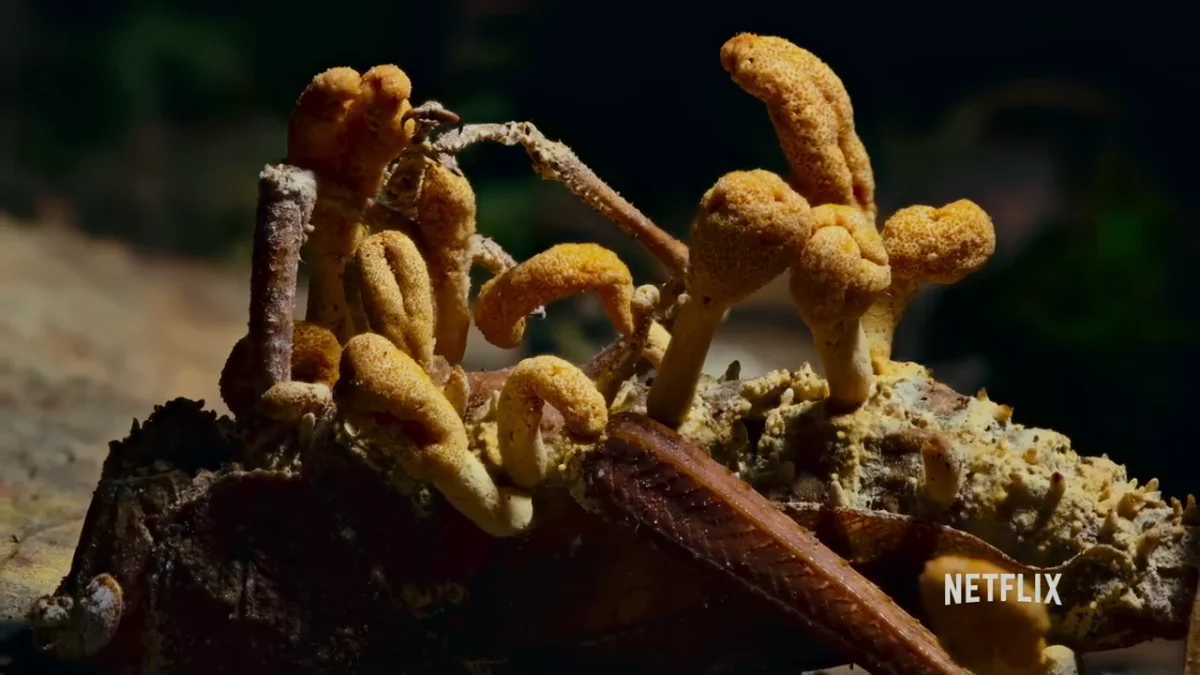A still-green leaf trembles in the understory. Clinging to its underside, an ant hangs motionless, mandibles locked tight, while a slender stalk erupts from the back of its head like a dark periscope. The scene is both mesmerizing and unsettling—the calling card of the parasitic fungi we’ve come to know, perhaps too casually, as the “zombie” makers.
A parasite with a plan
Cordyceps is a catchall name for a group of entomopathogenic fungi that infect insects and other arthropods. In tropical forests, the most notorious is the Ophiocordyceps unilateralis complex, a specialist that targets carpenter ants and rewrites their behavior with uncanny precision.
The story begins when airborne spores land on an ant’s exoskeleton. With a combination of pressure and cuticle-dissolving enzymes, the fungus bores through the armor and shifts into a yeast-like phase, quietly multiplying in the host’s body while evading its immune defenses.
Days later, the infection pivots from stealth to steering. The ant abandons its normal trails, descends to the understory, and seeks a very specific microclimate of temperature and humidity. It then bites down on a leaf vein or twig in a “death grip,” anchoring itself in place for the fungus’s grand finale.
Precision mind control
Field studies have shown that infected ants latch on at consistent heights and orientations where conditions favor fungal growth—behavior too patterned to be chance. Researchers have found the fungus permeating muscle tissue and interfacing with the ant’s motor systems, suggesting the command comes from changes to the body’s mechanics rather than a simple takeover of the brain.
The effect is choreography, not chaos. By guiding its host to a sweet spot and locking the jaw muscles, the fungus builds a living scaffold that keeps the cadaver steady during the critical reproductive phase.
After the takeover
Once the ant is fixed in place, a club-like stalk pierces out from the head capsule. This structure matures into a spore-bearing fruiting body, a miniature siege engine pointed at the forest floor where other ants roam.
When conditions are right, the fruiting body releases cascades of spores that drift downward like microscopic confetti. In dense colonies, the rain of spores can seed new infections below, carving out “kill zones” that worker ants learn to avoid through collective, social immunity—an elegant example of how societies evolve to counter parasites.
From stealthy entry to locked-jaw finale, Cordyceps runs its life cycle with clockwork precision tuned to the forest’s microclimate.
Ecology of control
For all its cinematic strangeness, Cordyceps plays a straightforward ecological role: it helps regulate insect populations. In tropical systems where ants dominate the biomass, that check-and-balance keeps energy moving and niches open.
The fungus itself is embedded in a web of relationships. Hyperparasitic fungi sometimes attack Cordyceps fruiting bodies and sterilize them, blunting outbreaks. Ant colonies respond with hygienic behaviors—grooming, quarantining, and removing the dead—to contain the threat. What looks like horror on the individual level becomes stability at the ecosystem scale.
A made-for-TV villain—grounded in reality
Nature documentaries have turned Cordyceps into an icon of the uncanny. Slow-motion sequences, like those in Netflix’s global nature series Our Planet, make visible what usually happens out of sight: spores blossoming, stalks unfurling, the eerie stillness before a cloud of life is launched.
Popular culture has pushed the fungus even further, imagining a human pandemic. In reality, Cordyceps species are highly specialized for their hosts. Their biology is tuned to insect bodies and insect temperatures, and no evidence suggests the ant-controlling species can infect people.
That said, scientists do keep a careful eye on fungi broadly, especially as the planet warms. Warmer conditions can select for fungi that tolerate higher temperatures, potentially narrowing the protective gap created by human body heat. Recent emergence of heat-tolerant pathogens in healthcare settings underscores that vigilance, even if the zombie-ant fungus itself is not a candidate for a leap to humans.
What scientists are learning
The mechanics of manipulation remain an active frontier. Tissue studies have shown that Ophiocordyceps threads, or hyphae, spread through the ant’s muscles and cluster near junctions that control movement, hinting at a chemical or biomechanical form of remote control. The ant becomes a puppet whose strings are built from inside.
Chemistry offers another lens. Compounds produced by Cordyceps, such as cordycepin, are under study for antiviral, anti-inflammatory, and anticancer potential in the lab. While clinical applications are not yet proven, the fungus’s molecular toolkit is already informing drug discovery pipelines.
Agriculture, too, is watching. Entomopathogenic fungi—including relatives like Beauveria and Metarhizium—already serve as biological controls against crop pests, reducing reliance on chemical insecticides. Understanding the specificity and safety of Cordyceps-line fungi could expand that toolkit without collateral damage to beneficial insects.
The forest’s hidden metronome
Look closely at a “zombified” ant and you see more than a grisly spectacle; you see timing. The bite happens as temperatures dip and humidity rises in late afternoon. The stalk matures during stable weather windows. Spore release tracks the rhythms of the forest like a metronome you can’t hear but the ecosystem keeps time to.
This choreography becomes a quiet feedback loop. Ant societies adapt, neighboring fungi exploit openings, and the forest’s balance is maintained not by a single actor but by an ensemble—Cordyceps taking a solo only long enough to complete its cycle and exit the stage.
What we should watch next
Better mapping of Cordyceps diversity—hundreds of species across climates and hosts—will show how fine-tuned parasitism evolves and how robust it is to change. Long-term field plots can reveal whether shifts in rainfall patterns alter the fungus’s kill zones or its seasonal timing, with cascading effects on ant communities.
Back in the lab, the quest is to decode the chemical language that turns a free-ranging worker into a climber with a locked jaw. Each insight closes the gap between eerie spectacle and explanatory power, transforming a viral moment on screen into a testable model of life’s more baroque strategies.

